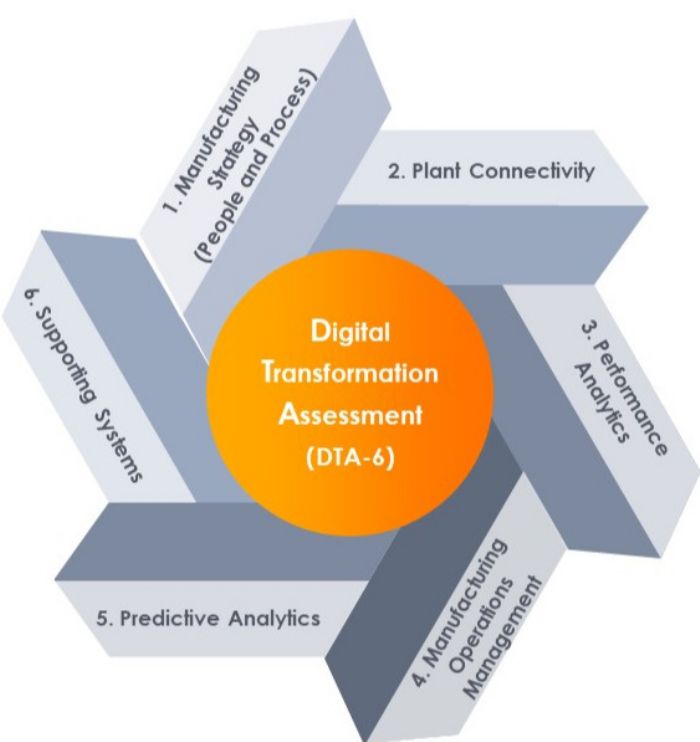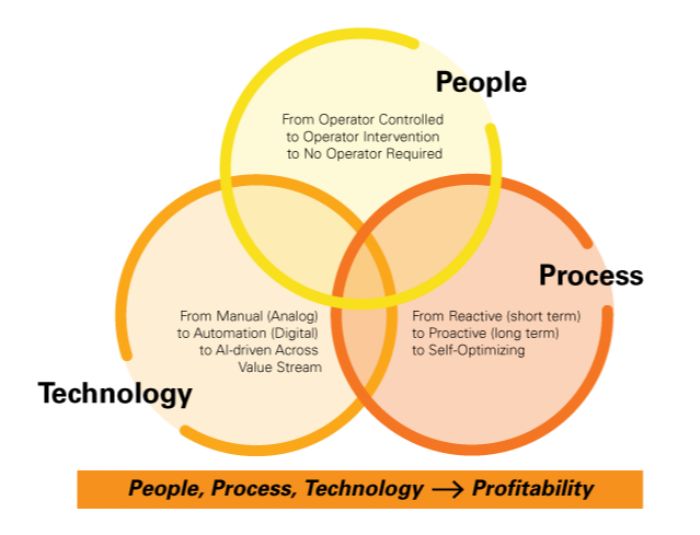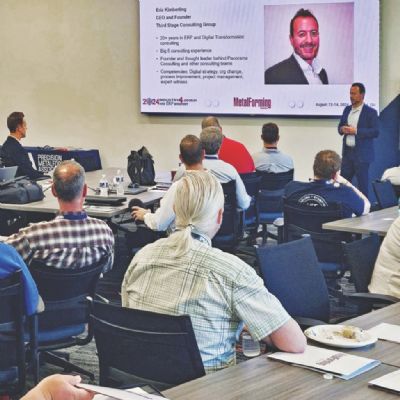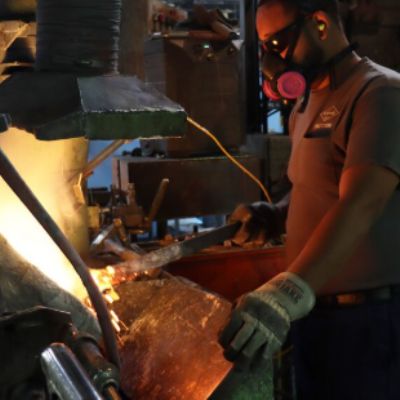That’s not true at all. In fact, we have visited facilities where money unwisely spent on expensive, high-tech equipment never delivered on its promise to improve the bottom line. The issue wasn’t the technology itself but a misunderstanding of when and where it’s meant to be implemented. One example: augmented-reality goggles on a production line moving too fast to take advantage of them. Technology comprises just one of three elements in the digital transition, along with people and process (Fig. 1).
Technology. A digital transition sees production equipment moving from manual or analog systems to digital, automated systems, to, eventually, artificial intelligence (AI)-driven systems across the value stream.
People. For your workforce, the transition means moving from workers operating individual machines continuously (even CNC machines) to fewer operators only needing to intervene with production equipment occasionally, to an ideal state where a machine needs no operator. Not to say that people no longer comprise an important part of the production process. They are and will remain so. But people’s skills will be utilized in ways that take advantage of their natural intelligence, imagination and adaptability. In the near term, it means that people will not need to be trained for repetitive tasks better performed by machines.
 Process. In the digital transition, production processes move from reactive or short-term to proactive andlong-term. It’s the difference between fixing something when it breaks and replacing something just before it’s ready to break. The goal: Make the process self-optimizing, so that it improves automatically over time.
Process. In the digital transition, production processes move from reactive or short-term to proactive andlong-term. It’s the difference between fixing something when it breaks and replacing something just before it’s ready to break. The goal: Make the process self-optimizing, so that it improves automatically over time.
Note that those long-term goals—enterprise-wide AI-based systems and self-optimizing processes—are worth pursuing, but the more immediate goal: Get a good return on your investment and an improved bottom line.
Where to Start
“Where do we begin?”
We most often hear that question after making Industry 4.0 presentations. It’s asked by people who have read the descriptions of ahead-of-the-curve companies that already use data provided by sensors on networked production equipment—data analyzed and used to improve efficiency and throughput throughout the enterprise.
Sometimes, the larger companies with deep pockets have invested heavily in automation and newer technologies such as additive manufacturing, augmented-reality vision systems and machine-learning systems as part of their transformation. The frugal job-shop owner might conclude that the price tag of digital transformation resides out of reach. Does access to smart-factory benefits necessarily depend on investments in all of those areas?
The answer, fortunately, is no. Small-to medium-sized manufacturers shouldn’t sit still, but don’t need to lay out a lot of money too quickly. Even larger manufacturers should begin by starting small—in a single facility and even on a single proof-of-value production cell.
Think Big, Start Small—and Scale Fast
This advice comes from personal experience. When this article’s co-author, Isaac Bennett, worked for a Tier One automotive supplier a few years ago, he was assigned the task of investigating the state of each of the corporation’s plants around the world regarding production technology and practices.
The two-dozen-plus plants exhibited a huge range in production technology and practices. At the time, the plants in India and South America used little automation, while one in Germany used a lot. Some plants employed manufacturing execution systems while others didn’t. Often, various sections of the enterprise—manufacturing, IT, marketing, newly acquired companies—didn’t collaborate and their information and practices resided in silos. Some plants did not collect data, while others did but failed to act on it. No standard existed for data collection.
The corporation’s chief information officer and Bennett decided that they needed to perform an assessment of all the plants, then look at their processes and automation, then try to measure where each plant sat on the scale of preparedness for Industry 4.0. That gave them an idea of where to start at each plant.
The goal: Generate knowledge from data in order to transform the entire enterprise into a learning, agile organization, and enable rapid decision-making and adaptation processes throughout every part of the business and across all business-process areas.
They thought big, and the acquisition of this agility provided the company with a significant competitive advantage.
But actions occurred in increments—by starting small. Each of those plant assessments began with Bennett or another expert walking into a single plant, finding the people onsite with the right knowledge and authority, and helping them figure where they were and how to move forward. Such a stepped approach begins with a plant pilot project, one to act as evidence of the transition’s value to stakeholders before embarking on a wider rollout.
We recommend this approach.
Assessment Leads to Pilot Project
That small pilot project is this second of four stages in a digital transformation, preceded by assessment and followed by evaluation and scaling. The first step, assessment, provides the concrete answer to the question of “where do we begin?”
Assessment is performed with a team that includes the plant manager (or an appointed deputy) and managers of various departments such as production, maintenance, IT and others—all team members should know their systems inside and out. Their task: Document the processes and systems currently in use in order to assess what works well and where gaps exist in knowledge and capabilities. This includes a look at infrastructure and identifies critical work centers and data-collection points.
The assessment has a few specific objectives (Fig. 2). First, it considers and benchmarks the facility’s digital-transformation readiness. This includes a gap analysis, which not only documents the status quo of processes and technology but specifically delineates just how near or far that status quo resides from Industry 4.0 readiness. The comprehensive assessment considers these six areas of focus:
1. Manufacturing strategy. Review critical processes, products produced, and the manufacturing team members and roles driving and sustaining productivity.
2. Plant connectivity. Capture real-time, objective data from the factory floor.
3. Performance analytics. Contextualize your data into meaningful performance metrics such as overall equipment effectiveness to drive continuous-improvement efforts.
4. Manufacturing-operations management. Extend and integrate the shop floor (connected-machine data) to the top floor (business systems such as ERP) to harmonize production, inventory, quality and maintenance activities.
5. Predictive analytics. Explore use cases for predictive maintenance (zero downtime) and predictive quality (zero defect) based on AI, for critical assets and operations.
6. Supporting systems. Review the interoperability of IT/OT systems such as ERP, CMMS and PLM, and their usability by employees.
|
- A recent poll of industrial-company leaders shows that 95 percent of respondents agree that a digital transformation is essential to future success; the time to begin your digital transformation is now.
- A successful transformation calls for thinking big—but starting small and then scaling fast.
- The first task in the transformation process: working with onsite department heads to assess the current state and perform a gap analysis around technology, process and people.
|
Out of that assessment comes the pilot project, a production test bed that deploys technology and practices needed to fill in some of those assessment-identified gaps in a demonstrable way. We call it a proof-of-value project because that's exactly what it does—it shows that the improvements work.
The evaluation phase begins during this project. This step establishes a center of excellence (CoE) for studying and training stakeholders in the project’s processes and technologies. The final step: scaling the digital innovations throughout the rest of the plant and, eventually, through the rest of the enterprise in a phased rollout supported by the CoE.
Get Going!
To reiterate, as many of your competitors may already know, a digital transformation offers huge benefits, with huge risks resulting from procrastination. Whatever the size of your enterprise, for Industry 4.0, don’t be afraid to think big. But, start small.
Starting with a detailed assessment and following with an operational proof-of-value project enables achievement of a smart factory with minimal downtime, minimal scrap and defects, and maximized throughput based on equipment and processes that improve themselves over time.
It all starts with assessment. Find the weak links—in people, processes and/or technology—because benefits accrue only as far as the weakest link.
Even this first task, assessment, appears daunting. This activity, the first great stride on the road to Industry 4.0, —might sound risky and difficult, with unseen pitfalls that could lead to hours or months of wasted time.
But it needn’t be. Help and resources available from digital-transformation experts can lead a well-chosen onsite team though a successful digital-transformation assessment in only three days. It’s time to get started. MF
See also: Iotco, LLC
Technologies: Management, Sensing/Electronics/IOT
 The report polled hundreds of senior manufacturing and supply chain decision makers at companies producing medical-device, robotics, automotive, aerospace and consumer-electronics products.
The report polled hundreds of senior manufacturing and supply chain decision makers at companies producing medical-device, robotics, automotive, aerospace and consumer-electronics products.







 Process. In the digital transition, production processes move from reactive or short-term to proactive andlong-term. It’s the difference between fixing something when it breaks and replacing something just before it’s ready to break. The goal: Make the process self-optimizing, so that it improves automatically over time.
Process. In the digital transition, production processes move from reactive or short-term to proactive andlong-term. It’s the difference between fixing something when it breaks and replacing something just before it’s ready to break. The goal: Make the process self-optimizing, so that it improves automatically over time.

